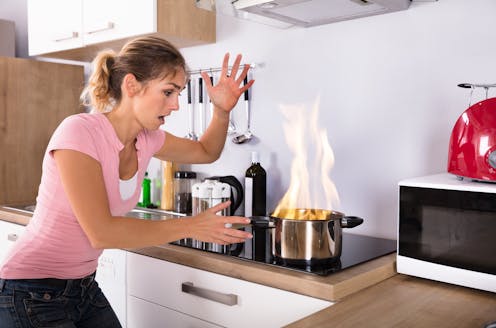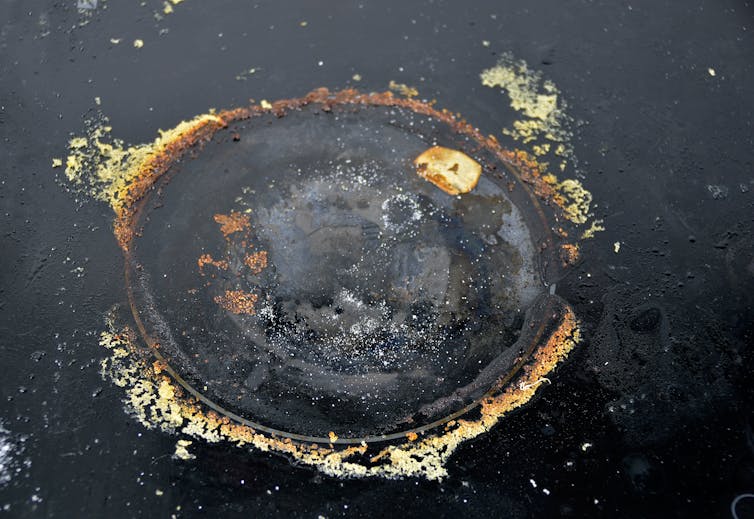
Most of us will spend more than two-thirds of our lives at home. But even indoors, many people will still be exposed to dangerous levels of air pollution – much of it resulting from cooking.
Food that is burned, seared or braised during cooking can produce tiny particles called particulate matter (PM2.5). Even food residue that collects in the oven or on the hob generates fine particles when burned. Research finds that you could be exposed to around three times more particulate matter while preparing a roast dinner than if you were to walk through India’s polluted capital, New Delhi.
When inhaled, these particles can affect the heart and lungs, worsening asthma symptoms and contributing to reduced lung function and airways irritation, and increasing the risk of a heart attack. In 2019, roughly 2.3 million deaths worldwide were caused by long-term exposure to household air pollution.
Many countries are retrofitting their housing stock as a way of reducing carbon emissions. The Irish government, for example, has pledged to retrofit half a million homes by the end of the decade. Retrofitting homes offers millions of people the opportunity to both improve indoor air quality and reduce energy use.
However, as retrofitting makes homes more airtight, ventilation needs to be properly managed and cannot depend solely on air leaking into the building to dilute concentrations of air pollutants. Without appropriate ventilation, the pollutants produced when cooking could be prevented from escaping into the atmosphere.
Homes in western Europe have long relied on natural ventilation, so the move towards airtight homes requires some life adjustments from their occupants.
Ventilating our homes
As part of retrofitting, homes will often have mechanical ventilation systems installed. This could be as simple as a cooker hood in the kitchen or an exhaust fan in the bathroom. But some homes will instead be equipped with a full service heating, ventilation and air conditioning system that takes in and cleans outside air, before cooling or heating it.
A cooker hood is a canopy that covers the cooking area with a built-in fan, sucking air through a series of filters before venting it outside. Using your cooker hood is one of the most effective ways to reduce your exposure to particulate matter while cooking. Research finds that you could be exposed to around 90% less PM2.5 when cooking with a hood than without air extraction.
However, user behaviour can limit their effectiveness and the ability of the ventilation system to work correctly.

Risks remain
Last year, we surveyed 14 Irish homes that had been retrofitted at least 12 months earlier. We found that cooker hoods that meet the appropriate regulations are still often not used as intended.
We also found that half the homeowners surveyed did not understand how to use their ventilation system correctly. They said the main reason for this was a poor handover process, with information on how to operate these systems deemed to be insufficient.
Our study revealed that 70% of the homeowners surveyed were unaware of how to maintain their home’s ventilation system to ensure it continued to work effectively. A lack of maintenance can cause the ventilation system to become noisy and may reduce people’s willingness to use it.
Most homeowners were unaware of the sources and health risks of indoor particulate matter exposure and how this was related to cooking. It is a longstanding concern that occupants need to be better informed about the risks of indoor air pollution.
How to reduce your exposure when cooking
There are, however, several simple tips that people should follow to reduce their exposure to poor air quality when cooking.
Food residue that is stuck on the hob will start to burn as soon as the hob is turned on. Your exposure to airborne particles will therefore increase as soon as you begin cooking.
So, if you have a cooker hood, turn it on before you start cooking and leave it running for 10–15 minutes after you stop. This way, the concentration of particulate matter is unlikely to rise to unsafe levels and will dissipate quickly once you have finished cooking.

The cooker hood removes particles generated from the back rings of a hob more easily than from the front rings, where more pollutants can escape into the room. Using the back burners or cooker rings is therefore an effective way of reducing your exposure to harmful indoor air pollutants.
You can even pair your cooker hood with PM2.5 sensors to reduce your exposure further. These sensors provide alerts on pollutant levels and allow smart control of the hood, so it is switched on at specific times, for example, or when PM2.5 levels reach a certain threshold.
It is equally important to have your cooker hood inspected and maintained annually by the installers. Like servicing your car or boiler, getting your ventilation system maintained each year will ensure it continues to work effectively.
Cooking at home can increase our exposure to harmful air pollutants. In energy efficient homes, people need to be informed about how best to use their mechanical ventilation system to avoid such exposure. Adjusting to these systems will take some time, but through some simple tips and information, we can reduce our exposure.
Asit Kumar Mishra is funded by Sustainable Energy Authority of Ireland. He is a member of International Society of Indoor Air Quality and Climate and the American Society of Heating, Refrigerating and Air-Conditioning Engineers.
Marie Coggins received funding from the Sustainable Energy Authority of Ireland (SEAI) - 2018 National Energy Research, Development & Demonstration Funding Programme. Radon monitoring in the same research project, was funded by the Irish Environmental Protection Agency (EPA). The project team would like to thank the homes who participated in this study. Coggins is an Irish representative and board member on the International Energy Agencies, Technology collaboration Programme - Annex 5, Air Infiltration and Ventilation Centre (AIVC).
This article was originally published on The Conversation. Read the original article.







